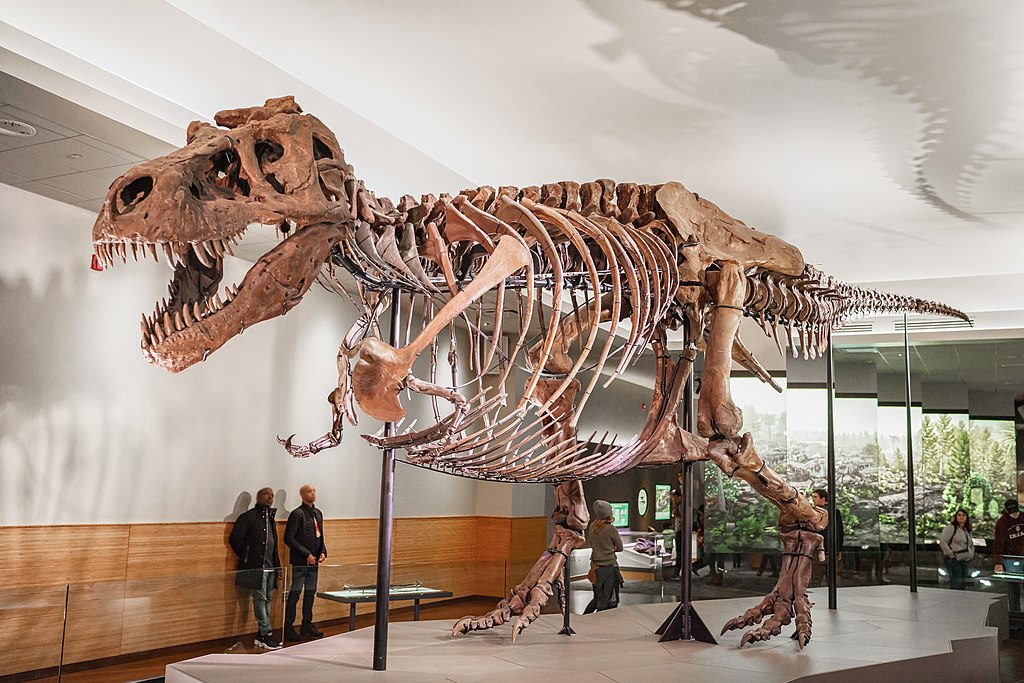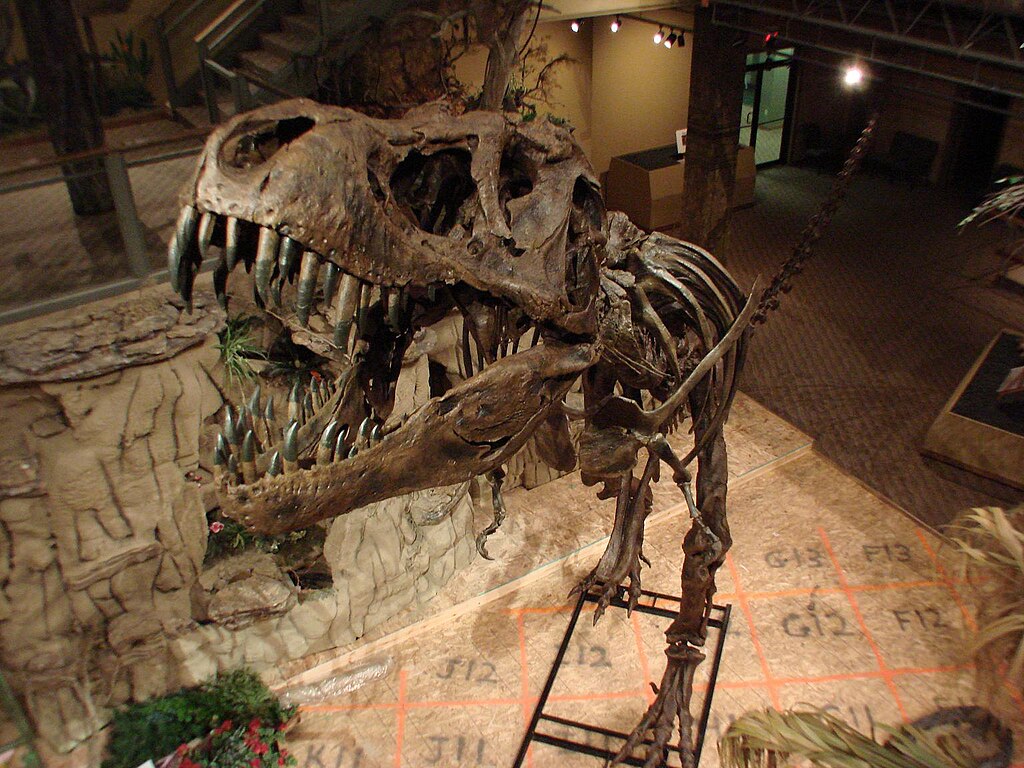In the world of paleontology, few discoveries have generated as much controversy as the skeleton known as “Sue” – the most complete Tyrannosaurus rex fossil ever found. Unearthed in South Dakota in 1990, this remarkable specimen quickly became the center of a bitter ownership dispute that would take years to resolve. Beyond the legal battle, Sue’s discovery sparked intense scientific debates about fossil ownership, commercial paleontology, and the very nature of scientific access to important specimens. This extraordinary case highlights the complex intersection between science, law, private property, and the public interest in our planet’s prehistoric past.
The Discovery of a Lifetime

On August 12, 1990, paleontologist Sue Hendrickson was exploring the Cheyenne River Indian Reservation in South Dakota when she noticed several vertebrae protruding from a cliff face. What followed was the revelation of the most complete Tyrannosaurus rex skeleton ever discovered, with over 90% of the bones intact. The fossil, affectionately named “Sue” after its discoverer, was approximately 67 million years old and measured about 40 feet long. The Black Hills Institute, led by Peter Larson, who had hired Hendrickson, carefully excavated the fossil over the next 17 days, paying landowner Maurice Williams $5,000 for the rights to the specimen. Little did they know that this momentous scientific discovery would soon plunge them into one of the most complex legal battles in paleontological history.
The Tangled Web of Land Rights

The legal complexities surrounding Sue stemmed from the peculiar status of the land where the fossil was found. Maurice Williams, a rancher of Sioux ancestry, owned the land but held it in trust with the federal government due to his Native American heritage. This trust relationship created a legal gray area regarding who had the authority to sell fossils found on the property. The situation was further complicated by the fact that the land was located within the boundaries of the Cheyenne River Sioux Reservation, adding a layer of tribal jurisdiction to the already complex scenario. These overlapping authorities created the perfect storm for what would become a years-long legal battle over who rightfully owned one of the most significant paleontological finds of the century.
The Dramatic FBI Raid

On May 14, 1992, in a scene more reminiscent of a drug bust than a paleontological dispute, the FBI and National Guard descended upon the Black Hills Institute in Hill City, South Dakota. Agents seized Sue’s remains along with numerous other fossils and documents, loading them into trucks while stunned locals watched in disbelief. The dramatic raid shocked both the scientific community and the small town that had already begun to see Sue as a local treasure and tourist attraction. The government claimed that the fossil had been illegally taken from federal land, while the Institute maintained they had legitimately purchased the specimen from the landowner. This high-profile seizure marked the beginning of a legal battle that would span four years and raise fundamental questions about fossil ownership in America.
The Legal Battle Unfolds

The court case over Sue’s ownership became increasingly complex as multiple parties staked their claims. The federal government argued that since Maurice Williams’ land was held in trust, he had no right to sell the fossil without federal approval. Williams himself joined the lawsuit, claiming he never intended to sell the actual fossil, merely the right to excavate it. The Cheyenne River Sioux Tribe also entered the fray, asserting tribal jurisdiction over resources found within reservation boundaries. Meanwhile, the Black Hills Institute maintained that their $5,000 payment constituted a legitimate purchase. The case wound its way through various courts, eventually reaching the South Dakota Supreme Court, which ruled in 1994 that Sue belonged to Maurice Williams as the trustor of the land, effectively invalidating the Institute’s claim to the precious specimen.
The Auction That Shocked Science

Following the court’s decision that the fossil belonged to Williams, he made the controversial decision to sell Sue at public auction. On October 4, 1997, Sotheby’s in New York conducted what would become the first-ever auction of a dinosaur fossil, with Sue on the auction block. The scientific community watched in horror as museums and research institutions were forced to compete with private collectors for this priceless specimen. After intense bidding, the hammer fell at $7.6 million, making Sue the most expensive fossil ever sold. The winning bidder was Chicago’s Field Museum, backed by corporate sponsors including McDonald’s and Disney. While scientists were relieved that Sue would remain in public hands, the precedent of auctioning scientifically significant specimens raised serious concerns about the future of paleontological research and access.
A Criminal Investigation Takes Shape

While the civil case regarding Sue’s ownership was proceeding, a parallel criminal investigation targeted the Black Hills Institute and its principals. In 1993, a federal grand jury indicted Peter Larson and several associates on numerous charges, including fossil theft, money laundering, and customs violations. Though most charges were unrelated to Sue’s discovery, many in the scientific community viewed the prosecution as retaliation for the Institute’s public battle to keep the T. rex. After a lengthy trial in 1995, Larson was acquitted of the most serious charges but convicted of minor customs violations related to currency reporting and fossil transportation. He ultimately served 18 months in federal prison, a punishment many scientists and supporters considered grossly disproportionate to the technical violations. This criminal case further polarized opinions about commercial fossil hunting and its relationship to academic paleontology.
The Scientific Significance of Sue

Beyond the legal drama, Sue represents an extraordinary scientific treasure. With 90% of her skeleton recovered, including the rarely preserved gastralia (belly ribs), Sue has provided unprecedented insights into Tyrannosaurus’s anatomy and biology. Scientists have identified pathologies including healed broken ribs, leg bones with evidence of infection, and arthritis in several vertebrae, offering rare glimpses into the life and injuries of this apex predator. Sue’s skull, weighing over 600 pounds and measuring five feet long, is the largest and most complete T. rex skull ever found. The specimen’s exceptional preservation extends to microscopic details, allowing researchers to analyze bone cell structures and growth patterns. Despite the controversy surrounding her discovery, Sue has become one of the most studied dinosaur specimens in history, continually yielding new scientific insights decades after her excavation.
Commercial Versus Academic Paleontology

The Sue controversy threw into sharp relief the tensions between commercial fossil hunters and academic paleontologists. Commercial collectors argued they possessed the expertise and resources to locate and excavate fossils that might otherwise remain undiscovered or weather away, pointing to the Black Hills Institute’s careful excavation of Sue as evidence of their scientific rigor. Academic paleontologists countered that commercially motivated collecting prioritizes valuable specimens over contextual data crucial for scientific understanding, and worried that important fossils in private hands would be inaccessible to researchers. Sue’s case highlighted the genuine contributions commercial paleontologists could make while also raising valid concerns about scientific access and the preservation of contextual information. This debate continues today, with both sides acknowledging the need for some middle ground that serves both scientific advancement and private property rights.
Public Ownership Versus Private Rights

The Sue case fundamentally revolved around the question of who should own the remnants of Earth’s natural history. Many scientists and museum professionals argued that significant fossils represent a collective natural heritage that should belong in public institutions accessible to researchers and the general public. Landowners and commercial collectors countered that fossils, like minerals or other natural resources, should belong to whoever owns the land or legitimately purchases them. The case highlighted the lack of clear legal frameworks in the United States regarding fossil ownership, particularly on private lands. Unlike many other countries that declare fossils to be national patrimony regardless of where they’re found, the U.S. generally treats fossils on private land as the property of the landowner. Sue’s story forced a reckoning with the competing interests of science, private property rights, and cultural heritage that continues to shape paleontological practice today.
Sue’s New Home at the Field Museum

After the high-stakes auction, Sue found a permanent home at Chicago’s Field Museum of Natural History. Before public display, the fossil underwent two years of meticulous preparation and study, with specialists removing the rock matrix from the bones and creating a custom mount to support the massive skeleton. On May 17, 2000, Sue was unveiled to the public in a specially designed exhibition space within the museum’s central Stanley Field Hall. The display was revolutionary, featuring a modular design allowing individual bones to be removed for research while maintaining the integrity of the exhibit. Sue’s actual skull, too heavy for the mount, was displayed separately in a glass case, with a lightweight replica completing the mounted skeleton. The Field Museum’s approach balanced public access with continued scientific study, making Sue not just a spectacular attraction but an ongoing source of research and discovery for paleontologists worldwide.
Legislative Aftermath and Policy Changes

The Sue controversy prompted significant reconsideration of laws governing fossil collection in the United States. In the aftermath, the federal government strengthened regulations regarding fossils found on public lands, implementing the Paleontological Resources Preservation Act as part of the Omnibus Public Land Management Act of 2009. This legislation explicitly protected vertebrate fossils on federal lands and established clear permits and processes for scientific collection. Many states also revisited their laws regarding fossil ownership and collection, with some implementing stricter regulations to protect scientifically significant specimens. Meanwhile, scientific organizations developed stronger ethical guidelines for paleontological research, addressing issues of contextual data preservation and collaboration with commercial collectors. While the legal landscape remains complex, particularly regarding fossils on private land, Sue’s case directly influenced policy reforms aimed at balancing scientific interests with property rights.
The Legacy of the Sue Controversy

More than three decades after her discovery, Sue’s legacy extends far beyond her scientific importance. The legal battle fundamentally changed relationships between academic institutions, commercial fossil hunters, landowners, and government agencies involved in paleontology. Many museums developed more proactive approaches to significant fossil acquisitions, establishing funds and partnerships to secure important specimens when they become available. Commercial paleontologists, while still viewed with skepticism by some academics, gained greater recognition for their contributions to discovery and preservation. The fossil market itself transformed, with prices for premium specimens skyrocketing after Sue’s record-setting auction. Perhaps most importantly, the controversy raised public awareness about the scientific value of fossils and the complex issues surrounding their ownership and study, bringing paleontological ethics into broader cultural conversation.
Sue in the Public Imagination

Sue has transcended her scientific and legal significance to become a genuine cultural icon. The Field Museum developed an entire persona around the skeleton, including a popular Twitter account presenting Sue as a sassy, self-aware dinosaur with opinions on everything from paleontology to popular culture. Sue has been the subject of numerous books, documentaries, and educational programs, bringing paleontology to audiences worldwide. The skeleton has appeared in countless selfies, becoming one of the most photographed museum specimens globally. Beyond Chicago, a traveling exhibition featuring a cast of Sue has toured internationally, allowing millions who cannot visit the Field Museum to experience this remarkable fossil. Through merchandising, educational programming, and digital presence, Sue has become an ambassador for paleontology and a gateway through which many young people develop their first serious interest in science. This cultural impact represents perhaps the most positive outcome of the controversy that once threatened to keep this remarkable specimen hidden from public view.
Current Scientific Understandings of Sue

Research on Sue continues to yield new insights about Tyrannosaurus rex and the Cretaceous ecosystem. Recent studies using advanced imaging techniques have revealed previously undetected features of Sue’s anatomy, including additional foramina (nerve openings) in the skull that suggest sophisticated facial sensation. Analysis of Sue’s bone microstructure has provided evidence about T. rex growth rates, suggesting these massive predators reached their adult size through rapid growth spurts rather than continuous development. In 2018, the Field Museum updated Sue’s mount based on new scientific understandings, repositioning the gastralia to more accurately reflect current knowledge of theropod anatomy. Scientists have also used Sue’s remarkably preserved remains to investigate questions about T. rex locomotion, sensory capabilities, and hunting strategies. As analytical techniques continue to advance, this exceptional specimen remains at the forefront of paleontological research, demonstrating the enduring scientific value that justified the extraordinary efforts to keep Sue in the public domain.
Conclusion

The saga of Sue the T. rex encompasses far more than the discovery of a spectacular fossil. It represents a pivotal moment in the evolution of paleontology as both a science and a cultural practice. The legal battles, ethical debates, and scientific revelations surrounding this remarkable skeleton forced a reconsideration of how we balance scientific inquiry with property rights, commercial interests with academic research, and individual ownership with collective heritage. Today, as Sue stands majestically in Chicago’s Field Museum, she serves as both a scientific treasure and a monument to the complex human dimensions of paleontology. The skeleton that sparked a lawsuit and a scientific debate continues to educate, inspire, and occasionally provoke us—a legacy as enduring as the fossilized bones themselves.




